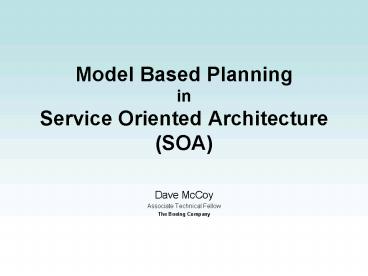Model Based Planning in Service Oriented Architecture SOA - PowerPoint PPT Presentation
1 / 17
Title:
Model Based Planning in Service Oriented Architecture SOA
Description:
XML-based format fuses visual and non-visual data. Works with major CAD/CAM systems ... Web Based 3D Viewer Integrated. http://www.lattice3d.com/3ddemo ... – PowerPoint PPT presentation
Number of Views:38
Avg rating:3.0/5.0
Title: Model Based Planning in Service Oriented Architecture SOA
1
Model Based PlanninginService Oriented
Architecture(SOA)
- Dave McCoy
- Associate Technical Fellow
- The Boeing Company
2
Definitions
- Service Oriented Architecture
- Service Oriented Architecture (SOA) is an
architectural concept where software
functionalities are exposed as services.
Service A Service is a software component
designed to be invoked by name across
applications or across organizations via a
well-defined interface
Existing Systems Or Services
Service Requestor
Service Provider
Network
Service Registry
Service characteristics Network-enabled
Self-contained Client-agnostic
3
SOA Attributes
- Smaller software components, and greater reuse of
standard software through plug and play approach - Heavily dependent of use of industry standards
and a robust network
Characteristics
- Business flexibility provided by increased
granularity of processes enabled through services - Ability to quickly create business processes and
composite applications to respond to changes in
the marketplace - Decrease development and deployment cycle times
through the use of pre-built, reusable services
building blocks
Benefits
4
What is Really Different
- 1970 - 1980s
- Monolithic applications
- Mainframe dumb terminal
- Little integration, Applications in functional
domains - 1990s
- Distributed applications
- Client server
- Integration within functions domains /
application suites proprietary - Early 2000s
- Loosely Coupled Applications
- Web enabled
- Integration using proprietary middleware and some
web services - Late 2000s
- Composite applications
- Rich web clients / portals
- Standards based integration and orchestration
Rigid Silos
Agile Collaboration
By 2008, Gartner predicts that SOA will be a
prevailing software-engineering practice, ending
the 40-year domination of monolithic software
architecture
5
Industry Trends
- Gartner
- By 2006, more than 60 percent of enterprises
will consider SOA a guiding principle in
designing their new mission-critical business
applications and business processes (0.7
probability). - By 2006, more than 75 percent of midsize and
large enterprises will have deployed SOA-enabled
development tools and middleware (0.8
probability) - Services-oriented development will dramatically
increase in near future.
6
SOA Maturity Gartner
7
IT Architecture Overview
Portal Service
CollaborationTools
B2B Interactions
ProcessOrchestration
BusinessIntelligenceServices
Applications Data
ServiceRegistry
Application functions are built as components
(or "services") that are loosely-coupled
andwell-defined to support interoperability,
and to improve flexibility and re-use
IBMs ESB Graphic
8
Evolution of Aerospace Assembly Planning
- 1970s
- Paper planning
- Word of mouth
- 1980s
- Electronic textual instructions
- Network
- 1990s
- More computer based textual instructions
- 2D graphical additions
- Internet
- 2000s
- 3D graphic additions
- Network bandwidth increases
- Web based textual/graphical instructions
- Model based work instructions
Text based
INFORMATION CONTENT
Model Based
By 2010, ..
9
Assembly Planning in SOA
2D Work Instructions
3D Work Instructions
Manufacturing Planning
Web Services
Automation
Web Services
Internet
Suppliers
Process Orchestration
PDM
10
Web Based 3D Viewer Integrated
XVL eXtensible Virtual world description
Language
11
XVL
- Develops standards-based XVL 3D format
- Provides 1/50-1/200 compression of 3D images
- order of magnitude better than currently
available - XML-based format fuses visual and non-visual data
- Works with major CAD/CAM systems
- Highly accurate
- Leverages 3D data across the enterprise by XVL
- Speeds development design cycles
- Allows departments and partners collaborate
- Enables automation and reduces costs for improved
Manufacturing, Customer Service, Marketing, etc.
12
Web Based 3D Viewer Integrated
http//www.lattice3d.com/3ddemo/SW/SW.html
13
Web Based 3D Viewer Integrated
http//www.lattice3d.com/3ddemo/AssemblyInstructio
ns/index.xml
14
Major Challenges
- Maturity of SOA
- Process Orchestration
- Vendor Support
- Interoperability Standards
- S95, OASIS, BPEL
This Is Where We Need To Work Together
15
Process Orchestration
Application
Process Logic
Functions
Today
16
Future
- Agile systems that adapt quickly to changing
markets and process requirements - Incorporation of new technologies
- Web Services
- XML, HTTP, SOAP
- Service Oriented Architecture
- Model Driven Enterprise
- Process Orchestration along Supply Chain
- IT Skills to Support New Environment
The Future Has Never Been More Exciting And
Challenging
17
Thank You































